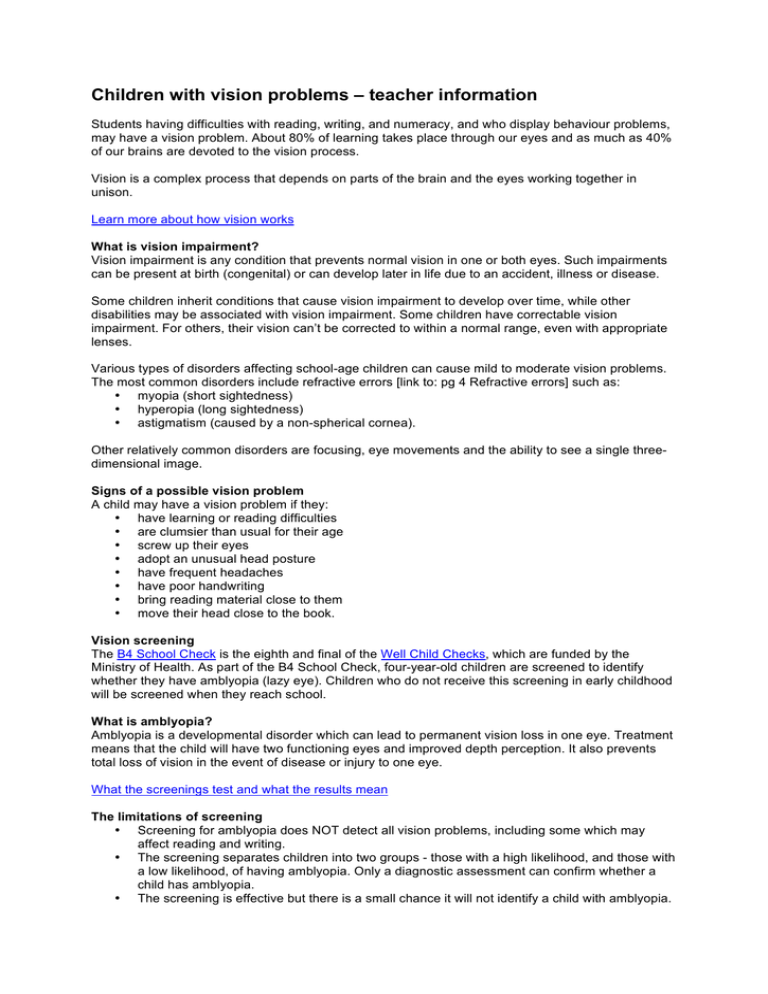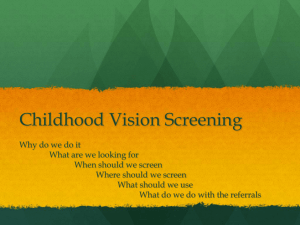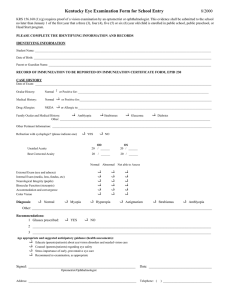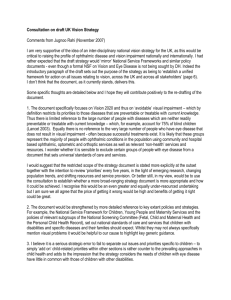Children with vision problems – teacher information
advertisement

Children with vision problems – teacher information Students having difficulties with reading, writing, and numeracy, and who display behaviour problems, may have a vision problem. About 80% of learning takes place through our eyes and as much as 40% of our brains are devoted to the vision process. Vision is a complex process that depends on parts of the brain and the eyes working together in unison. Learn more about how vision works What is vision impairment? Vision impairment is any condition that prevents normal vision in one or both eyes. Such impairments can be present at birth (congenital) or can develop later in life due to an accident, illness or disease. Some children inherit conditions that cause vision impairment to develop over time, while other disabilities may be associated with vision impairment. Some children have correctable vision impairment. For others, their vision can’t be corrected to within a normal range, even with appropriate lenses. Various types of disorders affecting school-age children can cause mild to moderate vision problems. The most common disorders include refractive errors [link to: pg 4 Refractive errors] such as: • myopia (short sightedness) • hyperopia (long sightedness) • astigmatism (caused by a non-spherical cornea). Other relatively common disorders are focusing, eye movements and the ability to see a single threedimensional image. Signs of a possible vision problem A child may have a vision problem if they: • have learning or reading difficulties • are clumsier than usual for their age • screw up their eyes • adopt an unusual head posture • have frequent headaches • have poor handwriting • bring reading material close to them • move their head close to the book. Vision screening The B4 School Check is the eighth and final of the Well Child Checks, which are funded by the Ministry of Health. As part of the B4 School Check, four-year-old children are screened to identify whether they have amblyopia (lazy eye). Children who do not receive this screening in early childhood will be screened when they reach school. What is amblyopia? Amblyopia is a developmental disorder which can lead to permanent vision loss in one eye. Treatment means that the child will have two functioning eyes and improved depth perception. It also prevents total loss of vision in the event of disease or injury to one eye. What the screenings test and what the results mean The limitations of screening • Screening for amblyopia does NOT detect all vision problems, including some which may affect reading and writing. • The screening separates children into two groups - those with a high likelihood, and those with a low likelihood, of having amblyopia. Only a diagnostic assessment can confirm whether a child has amblyopia. • The screening is effective but there is a small chance it will not identify a child with amblyopia. • Not all children receive their B4 School Check. More information about amblyopia Save Sight Society Prevent Blindness Your role in identifying children with potential vision problems A child may pass the screening tests and still have difficulties seeing well enough to function fully in the classroom and the school environment. You can play a key role in ensuring children with potential vision problems are seen by an eye-care professional or vision hearing technician. Vision hearing technicians Vision hearing technicians (VHTs) are trained to screen children for vision and hearing problems as specified in the national vision hearing screening protocols. Preschool screening is carried out on four-year-olds in early childhood education centres or clinic settings by VHTs who carry out the B4 School Check. Children who are not screened at this time will be screened when they reach school. VHTs screen Year 7 students (11-year-olds) for distance vision and boys are also tested for colour vision. If you are concerned about an unidentified vision problem Discuss your concerns with your student’s parents. Encourage them to arrange for a full vision assessment with their local optometrist or at the hospital eye department. Ask for details of the vision impairment and find out how to best adapt the school situation to suit the child better. What if families can’t afford assessments or glasses? A spectacle subsidy is available for some families to help pay for some or all of the cost of a vision assessment and glasses. It is funded by the Ministry of Health. To be eligible for this subsidy the: • child must be under the age of 16 • family must have a community services or high user card. All about the spectacles subsidy - includes information in a number of languages Things to consider for your classroom planning If you have one or more children in your class with a vision problem you may need to: • plan in advance for curriculum delivery • use the information gathered from parents/whānau and your own observations to inform decisions about curriculum resources and the learning environment • check that the learner can access the curriculum resources such as font and font size • ensure the appropriate technology is available • support the development of self help and independence skills • help the student develop social skills for positive interactions with their peer group and adults. If the student is enrolled with a visual resource centre, liaise with the Resource Teacher: Vision to discuss relevant adaptations that support learning and teaching. If you have a vision-impaired student in your class who is not enrolled with a visual resource centre, consider the classroom environment. How might it impact on the learner? Consider things such as seating and lighting. For further information: Access to Learning: a resource for children and young people with moderate vision impairment (a Ministry of Education booklet). Make documents and classroom environments accessible (BLENNZ) Where to find more support • Resource Teacher: Vision Resource Teachers: Vision (RTV) are specialist teachers who provide educational support to learners who are blind or vision impaired, and their families. Learners can have this support from birth to 21 years of age, even if they have complex needs. Services are delivered in partnership with parents and regular educators. These positions are based at visual resource centres. A Resource Teacher: Vision in action • Blind and Low Vision New Zealand The Blind and Low Vision Education Network New Zealand (BLENNZ) is a school that is made up of a national network of educational services for blind and low vision children and young people. Who can get BLENNZ services? • Blind and low vision children and young people from birth to 21, or to the end of their schooling • Parents and whānau • Teachers, teachers’ aides, education support workers and others involved in the education of the child or young person • Visual Resource Centres Twelve visual resource centres are staffed by specialist teachers who meet the unique educational needs of children with a vision impairment. The children on their roll range in age from a few months to 21 years. These centres are funded by the Ministry of Education. Find your nearest visual resource centre • Parents of Vision Impaired (NZ) Inc Parents of Vision Impaired can be a helpful support to families who have visually impaired children. Contact details are on their website. Refractive errors The most common type of vision impairment in children is refractive error. Refractive error is where one or both of a child's eyes are unable to bring parallel rays of light to focus on the retina. The three main types of refractive error are: 1) myopia (short-sightedness) – the child can’t see things in the distance clearly 2) hyperopia (long-sightedness) – the child can’t see things close up clearly (and if it’s severe enough, it affects distance vision as well) 3) astigmatism - caused by a non-spherical cornea and impairs both distance and near vision. In children, significant levels of refractive error may result in blurred near vision and/or blurred distance vision. Children may also suffer from strained or sore eyes, headaches, watery eyes and screwing up of the eyes. It is normal during the first few years of life for changes to occur in a child's eyesight. Most newborn babies are long-sighted but as they grow this typically decreases to the point where by around schoolage or early adolescence they have minimal or no refractive error. However if this process does not happen normally then permanent refractive errors such as short- or long-sightedness can develop. Current thinking on short-sightedness suggests that its development in children is influenced by a combination of genetic and environmental factors. There is some evidence suggesting that a propensity for myopia may be inherited, with certain ethnic groups (eg, Asian people) having a higher prevalence of short-sightedness than other ethnic groups (eg, Caucasian/ European people). However, other studies argue that environmental factors are more influential and that repeated and intense involvement in near-vision tasks, such as reading or computer use, may trigger the development of myopia. Other common vision problems in children Other common vision problems in children resulting in less severe visual problems are amblyopia (lazy eye) and strabismus (squint), as well as problems related to focusing, vergence and eye movement. Amblyopia Lazy eye is commonly found in infants and pre-school children. It can be caused by a refractive imbalance or other conditions such as squints or cataracts. The visual functioning of one eye is less than the other eye. Because the weaker eye receives less visual stimulation, physical changes take place in the brain. If left untreated, there may be permanent loss of vision in the weaker eye. Strabismus Strabismus is where a person is unable to direct both eyes simultaneously towards a single point. One or both eyes may turn inwards, outwards, up or down, either permanently or intermittently. Binocularity and vergence Binocularity is the ability to use both eyes together and unite two images into one three-dimensional image. Binocular vision occurs when the two eyes work together equally. Vergence is the turning of the eyes horizontally, either inwards (convergence) or outwards (divergence), enabling binocularity. • • Convergence is the ability to use both eyes together and turn the eyes inwards to maintain single vision at near distance. Divergence is the ability to use both eyes together and turn the eyes outwards towards a far object. Adapted from: See Here (2008) Improving services for children with mild and moderate vision impairment, JR McKenzie Trust, Wellington.


